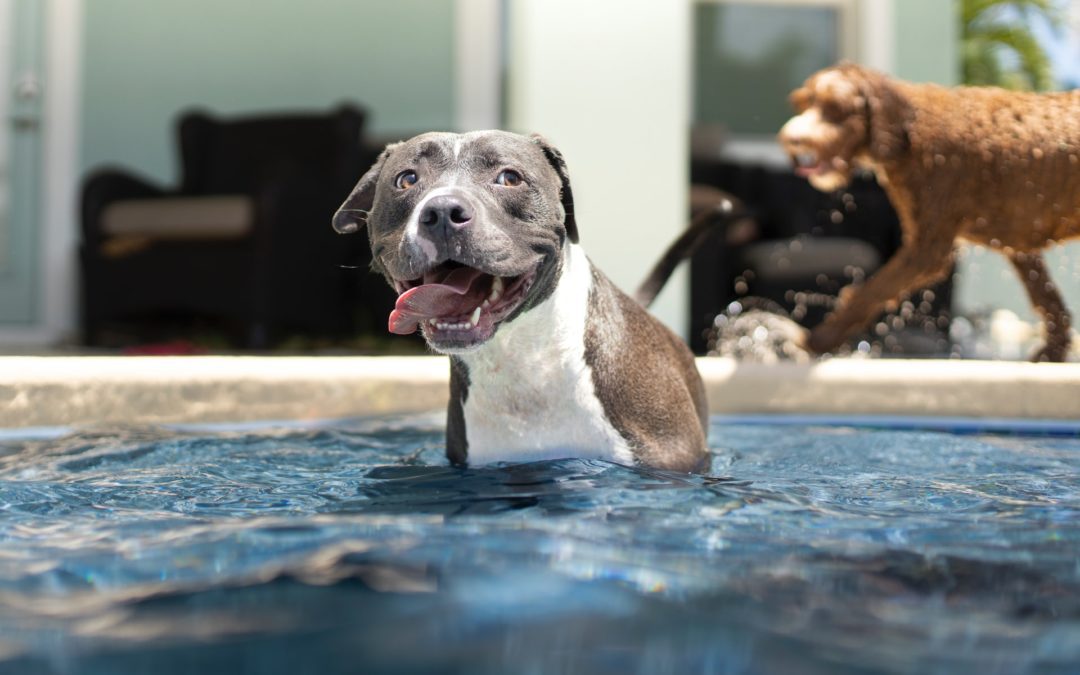Water Safety for Dogs
Denise Radford, DVM
It’s hot! Summer is in full force, and it is a scorcher! In this area, many of us find the water to be a great cure for the summer heat. Do our dogs think the same? How do we keep them safe, even if they can’t get enough of the water? Here are a few tips:
- Not every dog (or cat!) is a natural swimmer, and many are at least a little scared of swimming to begin with. Patience, positive reinforcement, and practice are important. Nobody likes to be tossed into the water unexpectedly – not even your dog!
- While you’re training, teach your pet how to exit the water. If you have a pool, you can easily teach them where the stairs or shallow spots are. If you travel often, you can “target train” with your dog – basically, teaching them that a certain distinct object or sound means “EXIT WATER HERE.” Look up “dog target training” or “dog touch training” for basics that can help with this.
- Lifejackets! Especially in open water, where there are waves or where children may be grabbing onto the dogs – life jackets are a must. My favorite types are the kinds with sturdy handles for lifting dogs up. I have seen a life jacket with a handle save the life of a dog who had a quick-thinking owner! You can also find life jackets that look like mermaids, sharks, butterflies, and other fun creatures. While they serve no function other than to make you smile and fill your socials with adorable pictures – if it also has a sturdy handle – 10/10, recommend.
- Many types of flea and tick products will wash off faster if it’s in the water a lot. Speak with your vet about picking a product that will not cause a lapse in coverage if you and your pet spend time in the water together.
- Watch for waves. Have you ever seen a dog do the doggy paddle? Their little faces don’t have much height over the water. Waves can easily engulf them, causing them to inhale water. In addition to drowning, inhaling water can lead to delayed inflammation or infection in the lungs, which could be severe enough to require hospitalization or death. Help your dog out of the water if you see waves coming.
- Not all water is for drinking. Would you willingly drink salt water from the ocean, a chlorinated pool, or fresh water from the Tennessee River? I hope you said no! Your dog doesn’t necessarily understand this logic, and they may think there is no other choice if they are thirsty. If they drink the water, correct them and offer them water you’ve packed for them instead. Collapsible silicone water dishes on carabiners and water bottles with fold-down bowls are two of my favorite dog accessories to travel with.
- Not all water is for drinking; part 2: Leptospirosis is a real, life-threatening sickness, and we see plenty of it in this area. In fact, dogs don’t have to be outdoor adventure enthusiasts to pick up this nasty bacteria. It attacks their liver and kidneys and can result in organ failure and death. Even city-slicking, apartment-dwelling dogs are at risk for Leptospirosis. Additionally, watch out for blue-green algae and steer clear of those areas at all costs. Despite the name, blue-green algae can come in many colors, so it’s best to avoid ALL algae. This type of algae contains toxins that rapidly affect the nervous system, GI system, and sometimes the liver. It can result in death within 15 minutes in severe cases.
- How long does it take you to get pretty exhausted while swimming? Chances are, you don’t know! Most people stop swimming long before they reach exhaustion. If your dog doesn’t know how to get out of the water, can’t signal to you that they need help, or simply doesn’t understand why they are getting so tired and what to do about it – they can become exhausted, leading them to gradually inhale little bits of water over and over, until they succumb. This is a tragic accident, but it can be prevented by understanding that you, as the human, must be the logical one and keep your dog from exerting themselves.
- Flat faces are extra trendy right now. Think – Bulldogs, Pugs, Frenchies—anything that snores, really! Those flat faces come at a cost. Even in cool conditions with no exercise, these guys struggle to breathe. Flat faces + heat + exertion can easily lead to a devastating episode of heat stroke. You must be extra careful about heat and exercise for flat-faced dogs – even if water is involved.
- When taking your pet onto the water with you – whether you’re paddling, floating, or boating – consider bringing a leash. Extra excitable dogs may be hard to keep up with in the water, and you don’t want them to get far enough away that they are difficult for oncoming traffic to see.
- If you have a backyard pool, keep pool chemicals up, safe, and far away from your pet. Even a bit of spilled pool maintenance product (like shock) can be deadly. Drinking a few licks from a properly maintained pool shouldn’t cause a problem.
- To keep your pet as healthy as possible, rinse them off after any swimming. It’s best for their skin! After you’re done, gently dry their ears to help prevent moisture buildup that can encourage infection.
Dogs make our lives better, especially during our summer pastimes. With these safety tips, you can be conscious of the risks that exist and make sure you’re doing all that’s needed to keep your dog safe! If you do find yourself in need of veterinary help due to a water or heat-related injury, you know where to find us. We are here for you and your pets 24/7/365.
Happy swimming!

